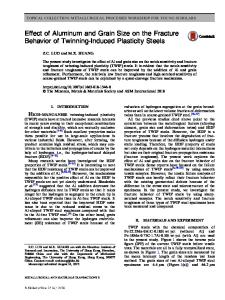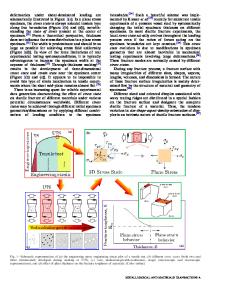Residual Stress Effect on the Delayed Fracture of Twinning-Induced Plasticity Steels
- PDF / 3,313,948 Bytes
- 5 Pages / 593.972 x 792 pts Page_size
- 21 Downloads / 404 Views
igh-manganese twinning-induced plasticity (TWIP) steels were developed several decades ago. Their outstanding mechanical properties drew attention from the automotive industry. Such superb mechanical properties are achieved due to deformation twinning during plastic deformation. The deformation twins during plastic deformation induce a high strain hardening by decreasing the dislocation mean-free path and increasing dislocation density, a phenomenon called the dynamic Hall-Petch hardening effect.[1–4] High strain hardening in TWIP steels allows high-stretch formability during sheet metal forming; hence the automotive industries
JUNG GI KIM, JAE IK YOON, SEUNG MI BAEK, and SUNGHAK LEE are with the Department of Materials Science and Engineering, Pohang University of Science and Technology (POSTECH), Pohang 37673, Republic of Korea. MIN HONG SEO is with the Technical Research Laboratories, POSCO, Incheon 21985, Republic of Korea. WON TAE CHO and KWANG-GEUN CHIN are with the HIMASS Research Project Team, Technical Research Laboratories, POSCO, Gwangyang 57807, Republic of Korea. HYOUNG SEOP KIM is with the Department of Materials Science and Engineering, Pohang University of Science and Technology (POSTECH) and also with the Center for High Entropy Alloys, Pohang University of Science and Technology (POSTECH), Pohang 37673, Republic of Korea. Contact e-mail: [email protected] Manuscript submitted October 25, 2016. Article published online March 13, 2017 2692—VOLUME 48A, JUNE 2017
want to apply it to next-generation automobile steel sheets.[5,6] However, TWIP steels have the problem of ‘‘delayed fracture’’ in deep drawing processes.[7,8] Many researchers have investigated the delayed fracture of TWIP steels and explained it from several viewpoints. Chin et al. reported that the addition of Al increases slip activities in TWIP steel by increasing the stacking fault energy[9] and improves delayed fracture life.[10] Kim et al. reported that the strain-induced phase transformation induces delayed fracture due to the changes of lattice structure.[11] Chun et al. revealed hydrogen embrittlement-induced delayed fracture due to the presence of the hydrogen trapping sites.[12,13] They also proved that dynamic strain aging (DSA) can affect the delayed fracture properties of TWIP steels due to strain localization during the plastic forming process.[14,15] The DSA effect induces strain inhomogeneity in TWIP steels, but another factor inducing inhomogeneous deformation is residual stress. It was reported that tensile residual stress was concentrated at the edge of a deep drawing processed specimen. Finite element simulation results[16,17] were in good agreement with the experimental ones: the concentrated tensile residual stress can initiate a radial crack.[10,18] Many results also revealed that residual stress concentration induces hydrogen embrittlement in non-uniformly deformed specimens.[19,20] Thus, controlling the residual stress is an important factor for improving the lifetime of plastic deformed metallic sheets. The residua
Data Loading...










